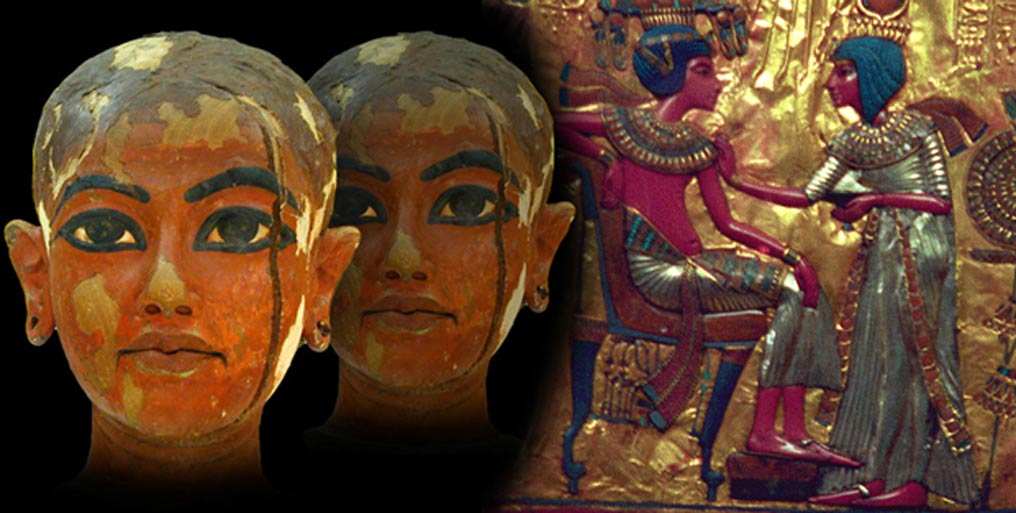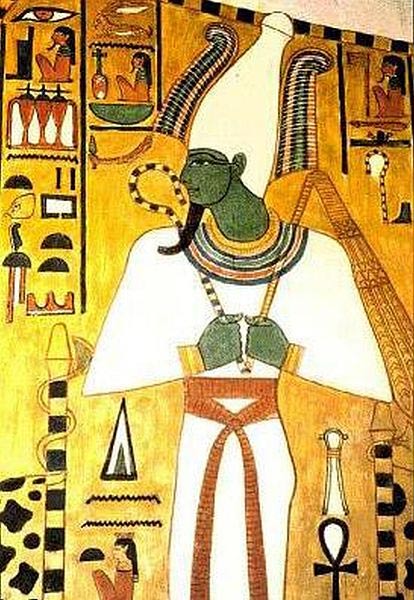Tossed away callously in a dark corner of the lavish Treasury in the subterranean tomb of Tutankhamun was possibly the most poignant remnant of the boy king’s short life.

Positioned next to the glittering canopic shrine that Howard Carter referred to as “the most beautiful monument”, was an uncovered and undecorated oblong beetle-ridden wooden box, whose lid was removed by ancient intruders. Inside, the British archaeologist discovered two exquisitely crafted miniature anthropoid coffins (Carter Nos. 317a and 317b) of gilded wood lying side by side. Placed head to feet, each one contained a nest of tiny coffins, like Russian dolls; within which were found the fetuses of two stillborn girls.
The occupants were not named, and so, despite sporting clay seals with the royal impression of the jackal over nine captives, these coffins were merely inscribed: “The Osiris”. Carter opined that they were “without doubt” the unfortunate daughters of the boy pharaoh and his consort Ankhesenamun.

Detail; Gold plate depicting Pharaoh Tutankhamun and consort, Ankhesenamun. (CC BY-SA 3.0)
Right from 1925 when the fetuses were first discovered, researchers have examined the remains many times over in a bid to determine their gestational ages and characterize any congenital abnormalities the children could have possibly inherited from their father.

Mummy of a child with a gilded face mask. Alexandria, Egypt. (Flickr/CC BY-SA 2.0)
Scholars, Studies and Scans
The first person to engage in such a study was Carter himself. He unwrapped the smaller fetus that measured less than 30 centimeters (11.8 inches) in height and estimated it to have been around five months into maturity; but was confounded by its state of preservation and the absence of an abdominal incision, which meant that the body was not mummified. Also, the archaeologist discovered a mask of gilded cartonnage over the head of the child and recorded that it was “several sizes too large”. In fact, a funerary mask seems to have been destined for the other fetus too, but was presumably discarded into a pit that contained embalming debris when it was found to be too small to fit over the head of the linen wrappings. This mask was discovered by Theodore Davis in 1907.

Cartonnage Mask. Egypt, 2nd century AD. (Public Domain)
In 1933, Dr. Douglas Derry, professor of anatomy at Cairo University, received the second mummy which was covered by a linen shroud fastened by transverse and longitudinal wrappings; beneath this lay a second shroud. Upon careful examination, the ace anatomist noted a further layer of “criss-cross bandaging and a series of pads which had been inserted for stiffening and shape,” Nicholas Reeves, notes in his book ‘The Complete Tutankhamun’.
The English Egyptologist adds that the same padding was used on the sides, legs and chest of the little mummy. Beneath yet more layers of large, transversely wound, and somewhat charred covering sheets lay a final layer of delicate linen, under which lay the body of a child measuring 36.1cm (14.2 inches) in length. Derry concluded that it was probably an embalmed female fetus.
The method employed to embalm this mummy was evident; for the skull had been packed with salt-soaked linen inserted through the nose, and an incision made in the groin to introduce more salted linen before sealing the opening with resin―though Alfred Lucas, expert forensic chemist whom Carter enlisted to help preserve artifacts recovered from the tomb, believed it was modified animal tissue of some sort.
In his report, which recorded many physical features, Derry noted that he saw “very fine downy-looking hairs” on the child’s head, and added, “The eyebrows are distinct and a few eyelashes remain.” This was proof of the extraordinary skill of ancient embalmers, according to Dr. Bob Brier, the world’s leading expert on mummies. This baby, Derry believed would, “… have been about seven months at the time of birth”. It is interesting to note that both the royal fetuses had their hands placed by their side, and not in the formal Osiride position.

Egyptian god Osiris, with hands in Osiride position. (Public Domain)
When Technology Met the “Twins”
Curiously, the little girls disappeared in the mid-1930s, and few experts were certain if they were in the Department of Anatomy in the Cairo University (where they were first kept in storage) or in the Egyptian Museum.
One specialist who knew the location of the fetuses was Professor R.G. Harrison. Around 1966-68 he helmed a team at the University of Liverpool that conducted radiography tests. Through his analysis, Harrison determined that the larger fetus had a condition known as Sprengel’s deformity, with congenitally high right scapula, spina bifida and scoliosis. This time, and against Derry’s findings over three decades earlier, the X-rays suggested that the child was at the most only one month premature, if not full term.
In 1978, radiographic examinations were once again performed on the larger mummy and it was concluded that the fetus suffered multiple congenital abnormalities of the scapula and spine, including neural tube defects and scoliosis.
Dr. Robert Connolly, an anatomist who analyzed the mummified remains of Tutankhamun and the stillborn children in 2008 observed: “The two fetuses in the tomb of Tutankhamun could be twins despite their very different sizes, and thus fit better as a single pregnancy for his young wife. This increases the likelihood of them being Tutankhamun’s children. I studied one of the mummies, the larger one, back in 1979, determined the blood group data from this baby mummy and compared it with my 1969 blood grouping of Tutankhamun. The results confirmed that this larger fetus could indeed be the daughter of Tutankhamun. Now we believe that they are twins and they were both his children.”
Over the years, some scholars have wondered whether the fetuses were tokens of purity that were placed in the tomb to journey with Tutankhamun into the afterlife. This ideation seems rather far-fetched, especially because the practice of human sacrifice to accompany royal burials was abandoned more than two millennia before the teenage pharaoh died.

CT Scan image of mummy. (The British Museum)
But the burial of these fetuses was not without precedent as Reeves explains, “Several 18th Dynasty parallels may be cited of royal children, predeceasing their father, being buried in the king’s tomb: Webensenu, a son of Amenophis II, buried in Valley Tomb 35; and Tentamun, Amenemhat and another, unidentified offspring in the tomb of Tuthmosis IV.”
The Road to Decay
Sadly, the mummies of these little humans had suffered a considerable amount of damage and deterioration over the years; due to their brittle constitution, and probably also because they were subjected to innumerable tests. Experts therefore began to ask themselves if post-mortem damage had been the primary factor for earlier suggestions of skeletal abnormalities.
In one of the latest rounds of tests in November, 2011 analysts at the Cairo University and the Department of State for Antiquities conducted a multi-detector computerized tomography (MDCT) study on both mummies and published their findings. The results were alarming, in that the images exposed the extent of damage the pitiable mummies had endured.
While the larger fetus displayed multiple post-mortem fractures of the spine, shoulders, arms, and feet; the smaller one showed no obvious signs of skeletal abnormalities. Further, the forensic images of the larger mummy revealed that the left shoulder was displaced upward and the clavicle was dislocated. This damage obviously occurred after mummification, and this was clearest evidence yet that the fetus did not suffer from a shoulder deformity.
- Kiya – The Most Mysterious Woman of Amarna
- Spanish Leak Reveals Hidden Chamber in Tutankhamun Tomb is Full of Treasures
- French Egyptologist Asserts that the Younger Lady is Really the Mummy of Nefertiti
So, post-mortem damage, and not inherited defects, was blamed for almost all other congenital abnormalities pertaining to the skull, arms, wrists, and feet. However, a slight curvature of the spine was the only physical deformity that could be noted by the researchers. At the end of the day, and after dozens of tests, Egyptologists are nowhere close to determining the true cause of death of either fetus.
Some scholars postulate that Tutankhamun was the product of a consanguineous marriage between his father Akhenaten and one of his sisters. And if his wife Ankhesenamun was his half-sister, could these elements of inbreeding have been the real reasons why the girls perished in the womb?
End of an Era
Workmen had hurriedly hacked at the toes of the resplendent outer coffin of her father, to make it fit into the sarcophagus. Strangely, the same discourtesy was inflicted on the larger child’s casket too. Conscious of all these touching details, Carter was stirred to lament, “… had one of those babies lived there might never have been a Ramses.”
![]()
The iconic Golden Mask of Pharaoh Tutankhamun. (CC BY 2.0)
Connolly suspects that the fetuses suffered from twin-to-twin transfusion syndrome, where the blood flow to the twins is unequal, making one grow much larger than the other. It was a syndrome that both children would have been unlikely to survive in ancient times.
It matters little if Ankhesenamun had suffered a couple of miscarriages, or just one, in which she birthed her doomed daughters. What is of consequence, however, is that the demise of these royal princesses sounded the death knell for the Amarna dynasty which was teetering on the brink of collapse ever since Akhenaten journeyed across the skies to be one with Aten. The smallest coffins, indeed, are the heaviest.